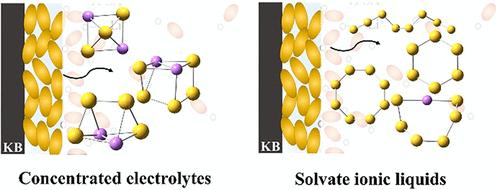Operando Raman Spectroscopic Analysis for Electrolyte/Electrode Interface Reaction in Lithium–Sulfur Batteries with Sparingly Solvating Electrolyte
IF 3.2
3区 化学
Q2 CHEMISTRY, PHYSICAL
引用次数: 0
Abstract
Understanding electrolyte/electrode interface reactions during battery operation is essential for the development and optimization of next-generation secondary batteries. There have been many reports on the discharge reaction mechanism in lithium sulfur batteries, which are next-generation secondary batteries. However, most of these reports are related to the sulfur reduction reaction, which is strongly affected by the electrolyte system. Here, we investigated not only the active material sulfur but also the electrolyte near the interface during discharging using operando Raman spectroscopic methods to reveal the discharge behavior in a Lithium sulfur battery with sulfolane (SL)-based concentrated electrolyte and lithium-glyme solvate ionic liquid (Li-G SIL). We have succeeded in experimentally demonstrating that the concentration polarization of Li+ occurs significantly in the Li-G SIL system with a low Li+ transference number. This is consistent with the fact that the intermediate products differ: the intermediates produced in the SL-based electrolyte system contain Li+, whereas in the G4-based electrolyte system, the chemical species containing Li+ is hardly confirmed. We believe that the difference in the Li+ concentration at the interface affects the overvoltage of the battery.

稀溶剂化锂硫电池电解质/电极界面反应的Operando拉曼光谱分析
了解电池运行过程中的电解质/电极界面反应对下一代二次电池的开发和优化至关重要。作为下一代二次电池,硫锂电池的放电反应机理研究已经有很多报道。然而,这些报道大多与硫还原反应有关,该反应受电解质体系的强烈影响。本研究利用operando拉曼光谱方法研究了活性物质硫和放电过程中界面附近的电解质,揭示了硫锂电池在含亚砜(SL)基浓电解质和锂-glyme溶剂化离子液体(Li-G SIL)的情况下的放电行为。我们已经成功地通过实验证明,Li+的浓度极化在Li+转移数低的Li- g SIL体系中发生显著。这与中间产物不同的事实是一致的:在sl基电解质体系中产生的中间产物含有Li+,而在g4基电解质体系中,含有Li+的化学物质几乎没有确定。我们认为界面处Li+浓度的差异会影响电池的过电压。
本文章由计算机程序翻译,如有差异,请以英文原文为准。
求助全文
约1分钟内获得全文
求助全文
来源期刊

The Journal of Physical Chemistry C
化学-材料科学:综合
CiteScore
6.50
自引率
8.10%
发文量
2047
审稿时长
1.8 months
期刊介绍:
The Journal of Physical Chemistry A/B/C is devoted to reporting new and original experimental and theoretical basic research of interest to physical chemists, biophysical chemists, and chemical physicists.
 求助内容:
求助内容: 应助结果提醒方式:
应助结果提醒方式:


